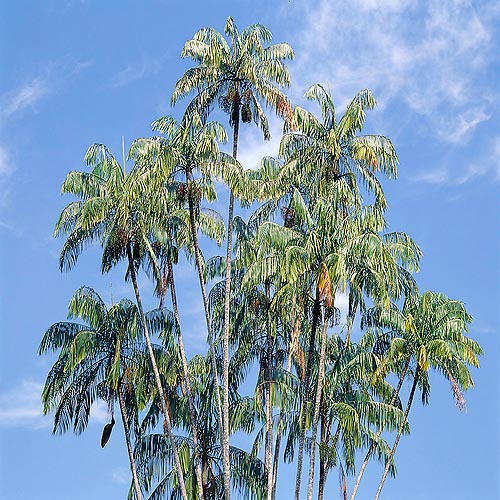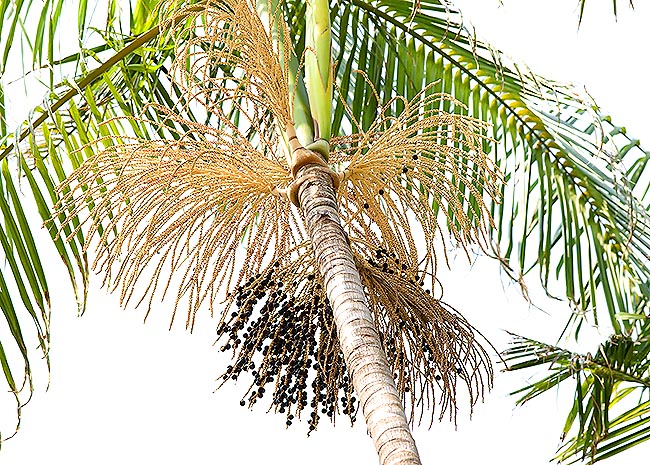Family : Arecaceae

Text © Pietro Puccio

English translation by Mario Beltramini

30 m tall cespitose with thorny trunks. Ornamental in the Tropics © Giuseppe Mazza
The generic name is the combination of the Greek terms “onkos” = swollen and “sperma” = semen; the specific name comes from the Latin “tigillum” = small rafter, with reference to the thin stems.
Common names: nibung (Malay); lao-cha-own (Thai); nibong palm, nibung palm, wild palm (English); palmeira-nibung (Portuguese).
The Oncosperma tigillarium (Jack) Ridl. (1864) is a densely cespitose species with trunks that may reach the 30 m with a diameter up to 15 cm, of light bronze colour on which are evident the rings trace of the junction of the old leaves, covered by numerous black thorns, flattened, up to 10 cm long and mainly facing downwards.
The foliar base, which wraps completely the trunk for a height of more than 1 metre, tubular, thorny, is of green-grey colour.
The pinnate leaves, on about 50 cm long petioles equipped with long blackish thorns, are about 3 m long, elegantly curved, with pointed, drooping pinnules, evenly distributed on the rachis, 3 cm broad and about 60 cm long in the median part.
The inflorescences, ramified and thorny, develop inside a spathe, also thorny, under the leaves, and are of bright yellow colour with flowers of both sexes placed in the typical triad (a female flower amidst two male ones).
The fruits, globose, 12 mm about of diameter, are blackish purple when ripe. It reproduces normally by seed which germinates in 2-3 months; the growth is fast. The trunks, without the thorns, are utlized as structural elements in the local dwellings due to their sturdiness, elasticity and resistance to the xylophagous insects; thanks to their long duration and resistance to rotteness even when immersed, in sweet or salt water, are used in the construction of big traps for fishes in the estuaries and of other submerged structures.

Flowers and fruits of Oncosperma tigillarium © Giuseppe Mazza
It is considered one of the most ornamental palm for the elegance of the foliage, but is relatively little cultivated, both for the presence of the thorns, and for its exigencies of cultivation, if not in large parks and gardens, in isolated tufts, in group or in row at the edges of the alleys, but far from passage locations.
It is cultivable, in full sun, only in areas with tropical climate, and partially subtropical, temperatures close to the 0 °C, even if for a short period, can destroy the whole aerial part. It adapts to any type of soil, though scarcely draining, but in with abundant and continuous availability of water, in presence of drought periods the plant begins to suffer if not duly irrigated, losing much of its charme.
Synonyms : Areca tigillaria Jack (1820); Keppleria tigillaria (Jack) Meisn. (1842); Areca nibung Mart. (1838); Areca spinosa Hasselt & Kunth (1841); Euterpe filamentosa Kunth (1841); Oncosperma filamentosum (Kunth) Blume (1843); Oncosperma cambodianum Hance (1876).
